The succulent terrarium is a fresh take on an old classic.
Where you can easily transform a simple collection of succulents into an elegant floral display in just a few simple steps.
In fact, this DIY succulent terrarium was one of the most straightforward and satisfying projects we’ve ever done. Perfect for a relaxing afternoon, kids’ activity, or for beginners looking to get their hands dirty.
So, in this guide, we’re going to take you through the entire process step-by-step. From plant and substrate selection to the vital planting tips that will make the whole thing pop.
Here’s how to make your terrarium a resounding succ-cess!

Terrarium Tribe is reader-supported. When you purchase through links on our site, we may earn an affiliate commission (at no further cost to you). 💜
Succulent Terrarium Layers & Planting (Step-by-Step)
First things first, let’s make sure we’re on the same page with the type of terrarium we’re making.
When it comes to succulent terrarium ideas for any DIY project – an open terrarium is the only way to go.
Seriously, succulents in closed terrariums are a big no-no. The high moisture and humid environment of a classic jar terrarium would quickly spell the end for these arid desert plants.
That’s why we’ve opted for an open glass container with a sloped curve. This kind of dish can provide lots of volume and airflow, with an aesthetic viewing angle to boot.
With all that said, let’s get into the build!
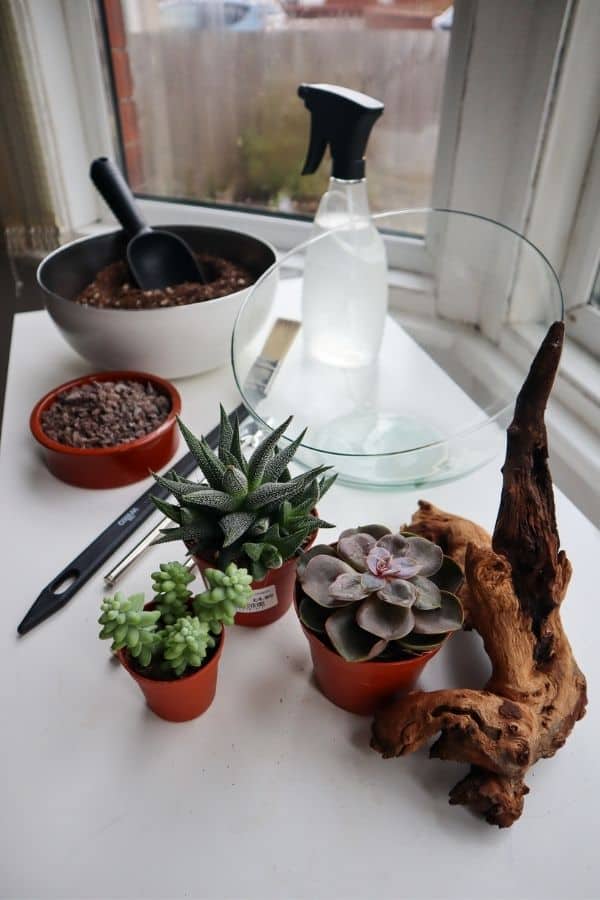
1 | Drainage Layer
Solid drainage is an essential part of a succulent terrarium.
After all, succulents are more sensitive to overwatering than even your most finicky tropical plants. They need to dry out between waterings and hate to be sat in a soggy substrate.
That’s why a drainage layer can be helpful here (also known as a false bottom).
By adding a layer of river rocks or gravel at the bottom of the terrarium, we can create a reservoir where any excess water can freely drain away – preventing the substrate from oversaturating and protecting the plants’ roots from rotting in the process.
1 to 2 inches of gravel should be enough, depending on the size of your container.
That being said, a proper watering technique is still the key to happy plants, and no terrarium layer will save you if you treat these like your tropical houseplants.
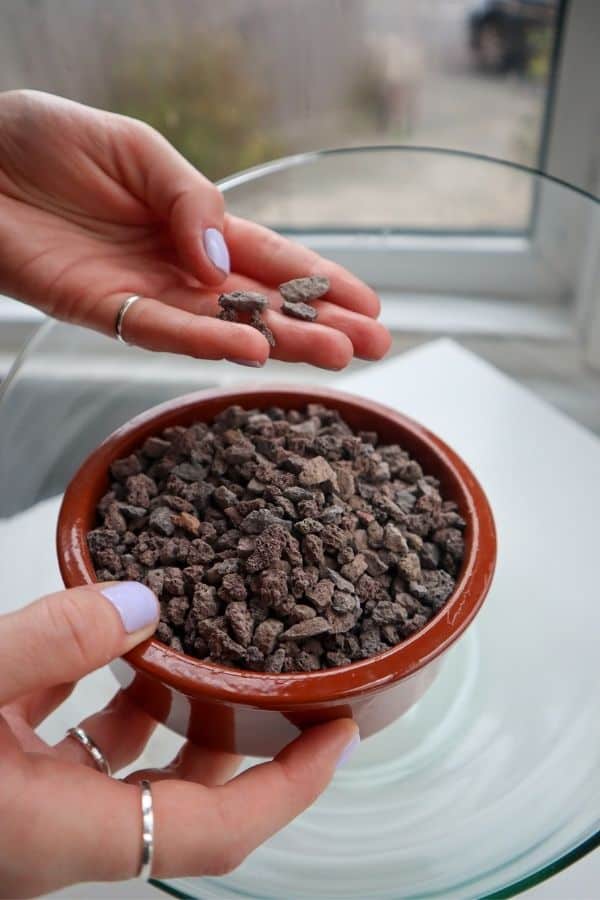
2 | Soil / Substrate
We’re still beating that drainage drum here, so your substrate choice is critical, too.
Seriously, your typical potting mix or tropical terrarium blend isn’t going to cut it. You need to buy (or create) a specialized mix for arid plants.
To prioritize drainage, look for a gritty mixture.
Mine is a mix of coco coir fiber, horticultural sand, pumice, activated charcoal, and a small amount of worm castings.
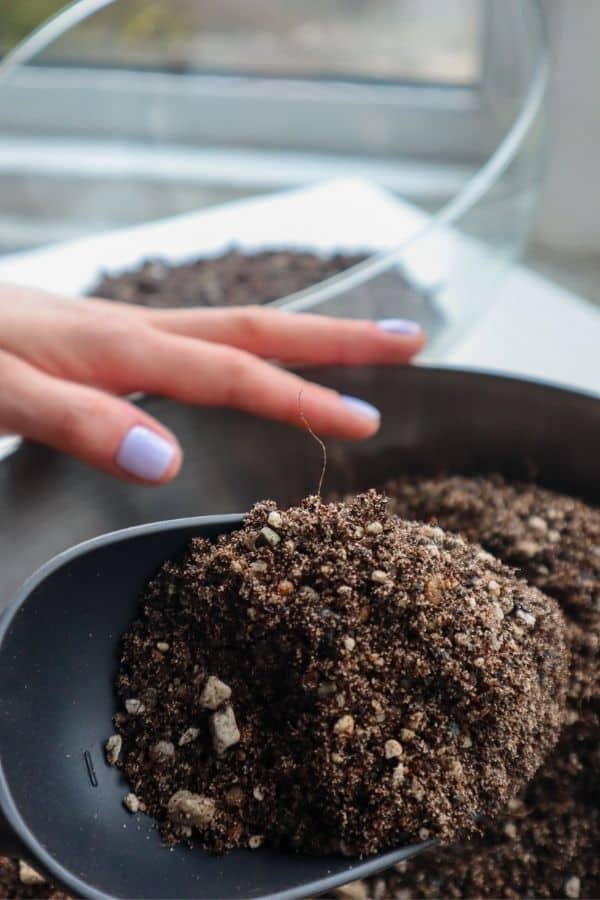
3 | Hardscape
Hardscape is a word used to describe any natural structural elements you might add.
Personally, I think it’s essential to a succulent terrarium (or any terrarium for that matter).
It’s what adds dynamic shapes to a scene and elevates a simple collection of succulents in a dish to something truly artistic. Look for gnarling hardwoods and textured rocks.
Though we tried a few combinations, this chunk of Mopani Wood just fit so perfectly.
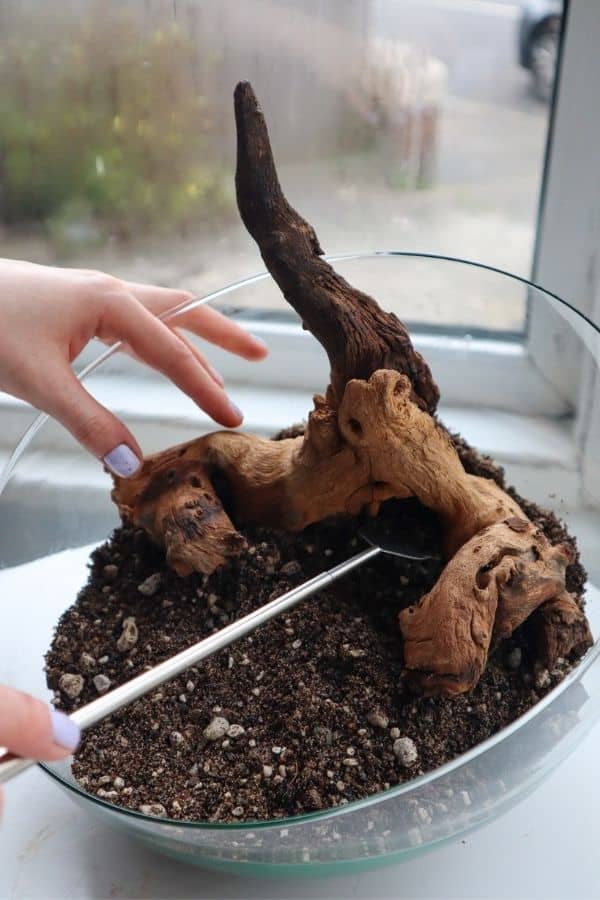
4 | Plants
Preparation
A bit of plant prep goes a long way before you start with the fun part.
First, it can be helpful to remove some of the existing substrates that your succulents are planted in. We can’t always be sure what it is, and you’ll have an easier time planting a smaller root ball.
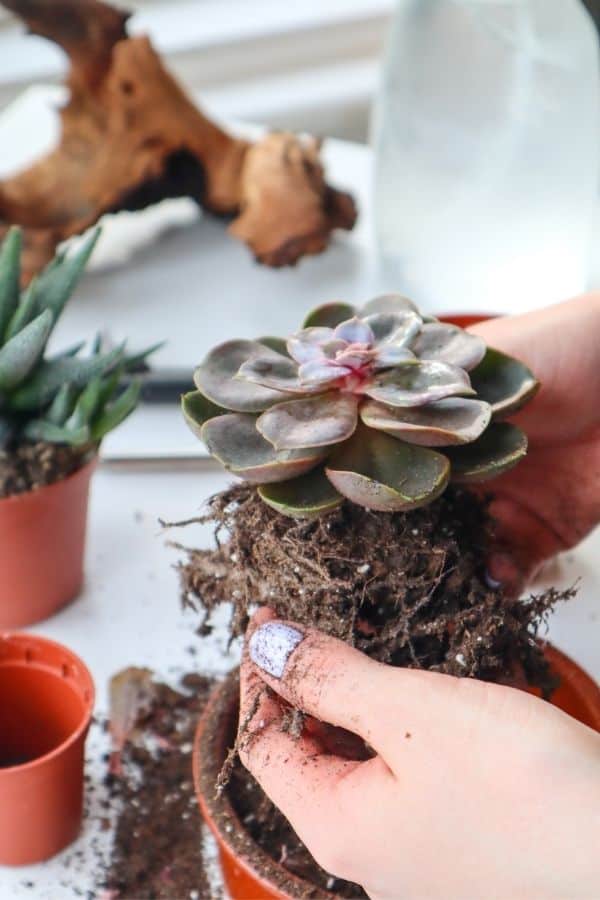
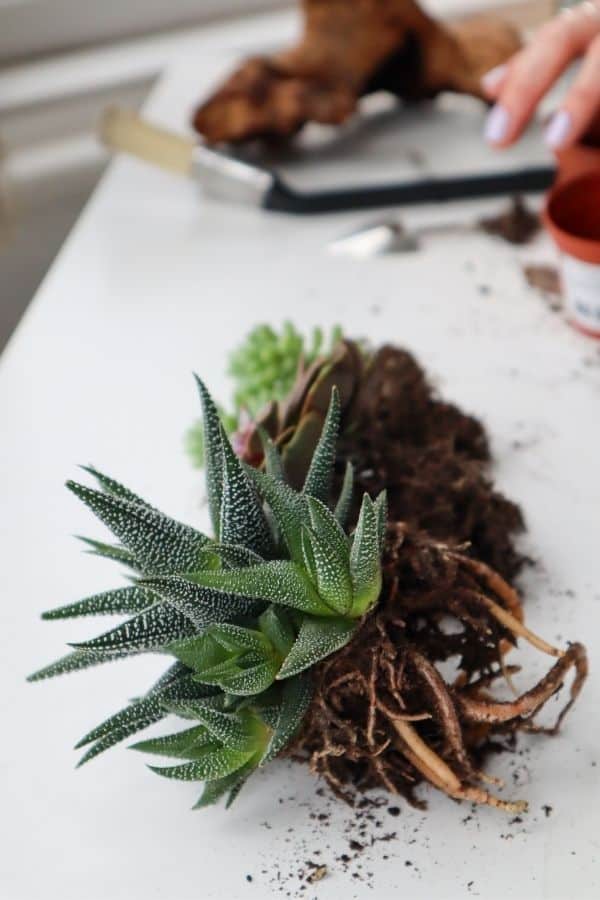
Depending on your choice of succulents, you may be able to separate some of them into smaller plants. This can be great in making your main plants a more manageable size, and you get the added bonus of some smaller accent plants to use.
Win-win!
For starters, we realized our Haworthia (the spiky one) had a few pups sprouting around the edges. These can be twisted off with some careful but firm pressure.
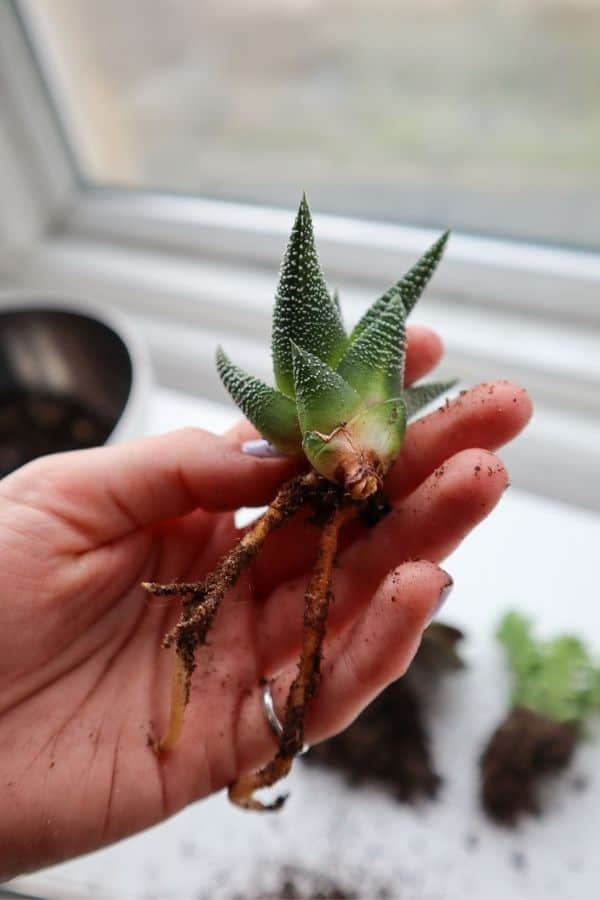
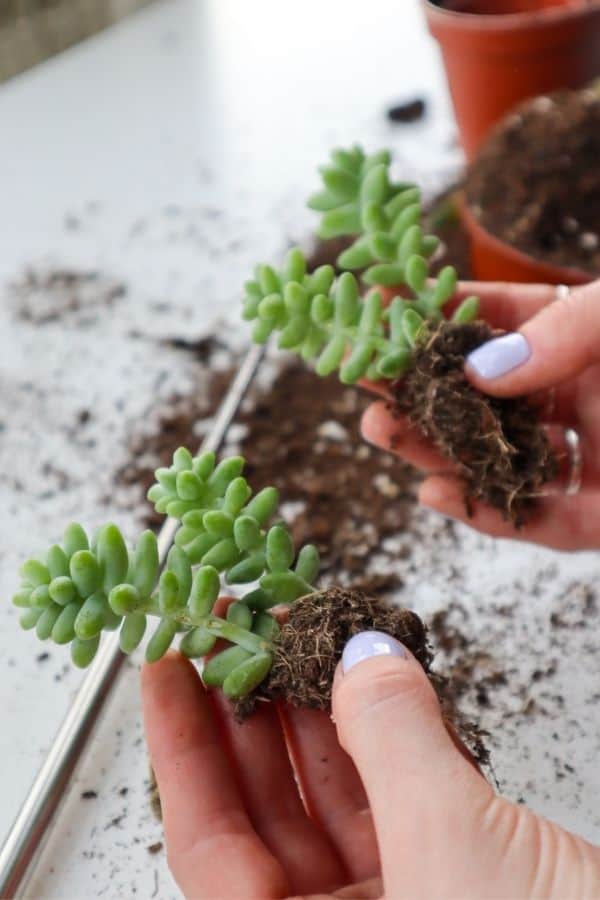
Planting Up
Okay, on to the fun part!
You can try giving your substrate a light spritz with a spray bottle if you like. It can help with the planting process by making the substrate more malleable.
Then, you want to create a suitably-sized depression in the substrate – just enough to accommodate the plant’s root ball. We use a little telescopic spade, but a spoon will work just fine.
First in, the Haworthia. As it’s the largest plant (even after removing the pups), it’s going to go center stage in the deepest part of the soil.
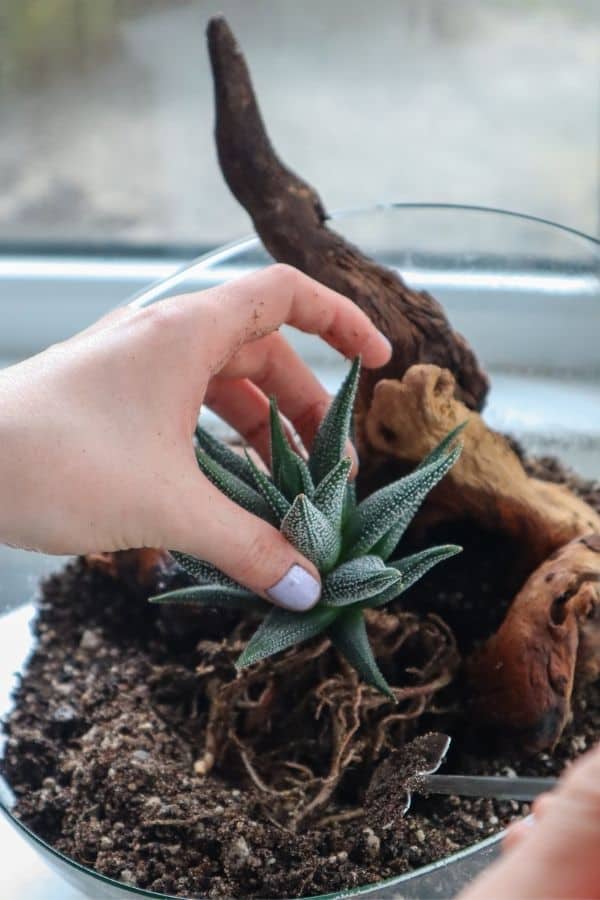
Next comes the gorgeous rosette of the Echeveria ‘Magic Red.’
There’s only one place this can go, really, but it slots in nicely next to the first succulent. The different shapes and colors complement each other well.
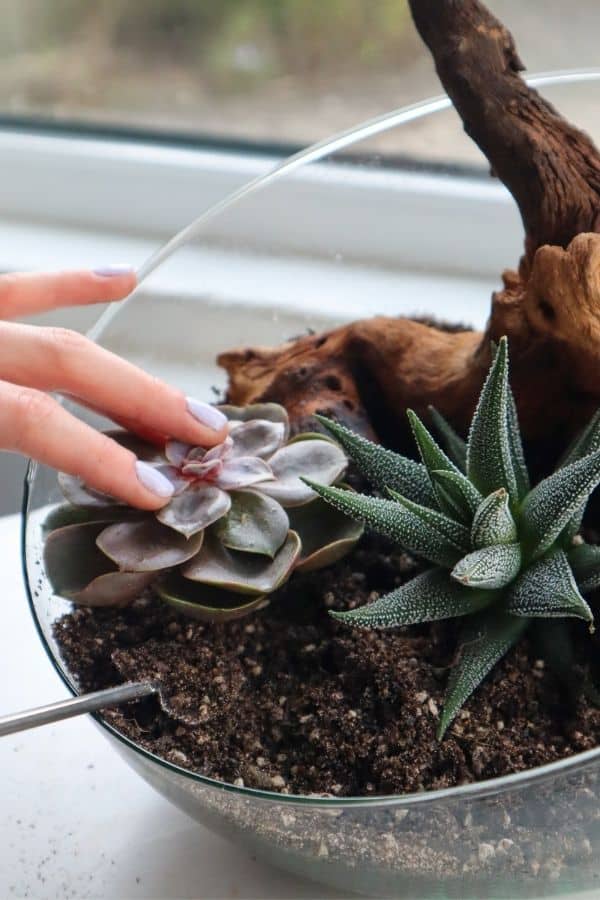
Finally, we add our accent plants.
We use 3 of the Sedum Burritos (because uneven numbers provide a more natural look) to add some verticality and to frame the main plants.
Then, we popped one of our Haworthia pups at the back to make use of the space.
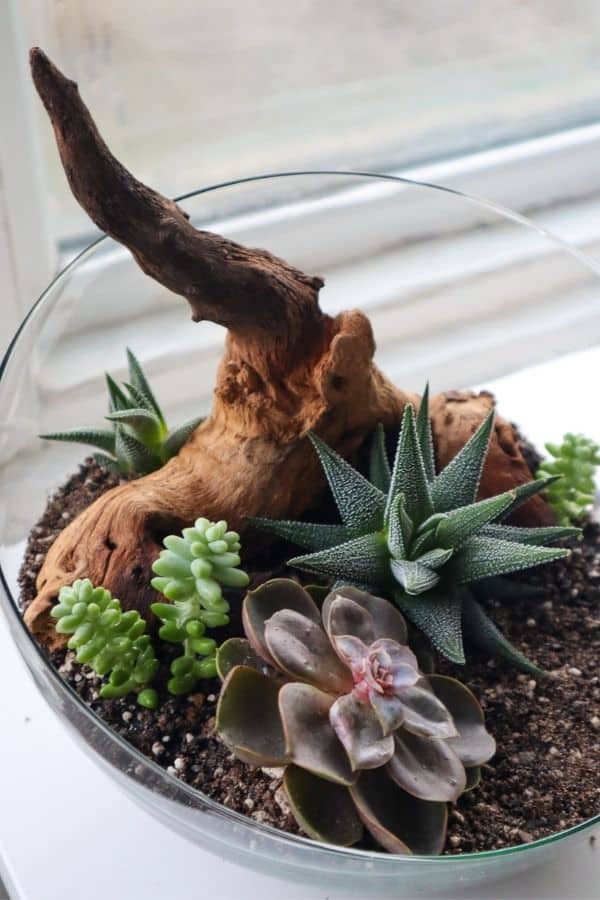
5 | Highlights
Here, we add the final touches to bring the whole piece together.
You may have noticed we still have some space at the front, too.
Now, it’s not critical that all of the soil ends up covered. It’s entirely down to personal preference (and succulent terrariums can easily end up too crowded).
But in this case, this is quite a big space, and I’m keen to add a different element in there to liven it up.
Good options include:
- More hardscape, e.g., rocks or smaller branches like Spiderwood.
- Different plants, e.g., Air plants or cacti.
- Preserved moss (live moss wouldn’t work in an open container).
- Shells, crystals, or figurines.
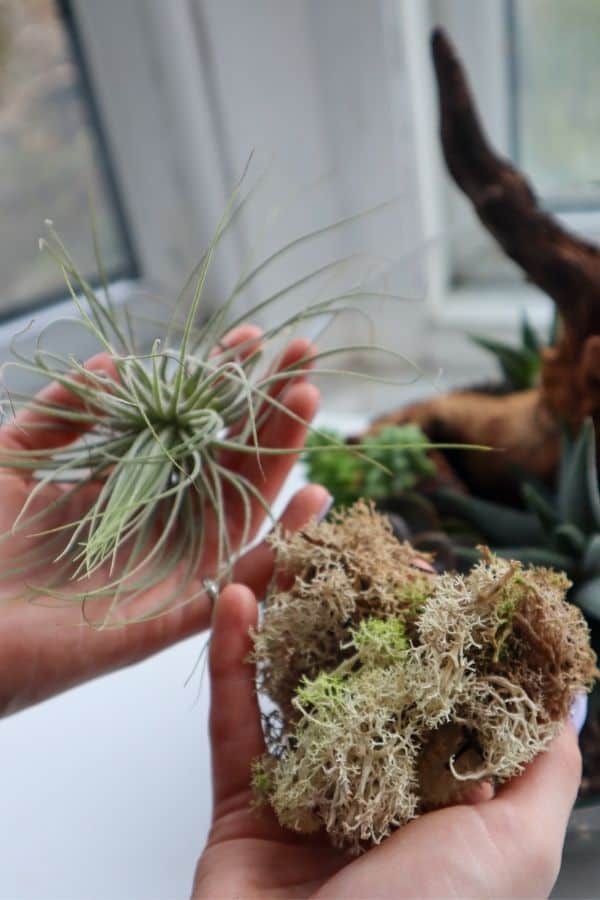
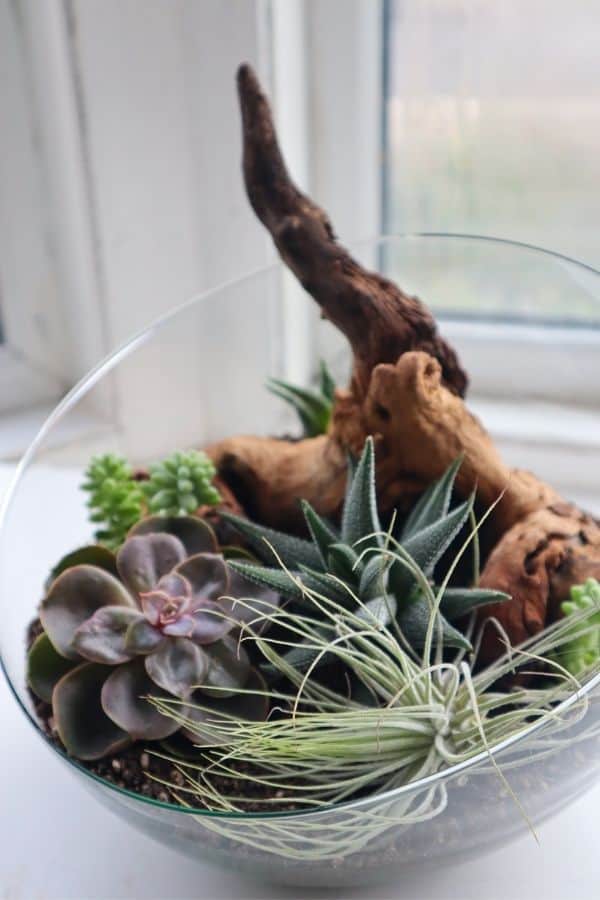
We opted for the air plant – Tillandsia magnusiana in this case – because the thin floaty tendrils contrast the thick succulent leaves nicely.
You could also add a top dressing of sand or gravel if you like, but we don’t feel it’s necessary here.
There we have it! We’re done.
Choosing Succulents for Terrariums
Now that we have the planting/building process down, we’re covering how to choose succulents for terrariums.
There’s a vast array of potential options out there, literally thousands.
Thankfully, many of them are suitable for succulent terrariums. Here’s what to look out for.
- You want as much variety in shape, color, and texture as possible. Contrast is the key to a dynamic-looking succulent arrangement.
- Smaller succulents are best. Some really do grow quite large and can quickly outgrow their space in a terrarium.
- Picking plants with similar care requirements is important. Though it’s pretty easy to do with succulents, there’s a lot of overlap between species.
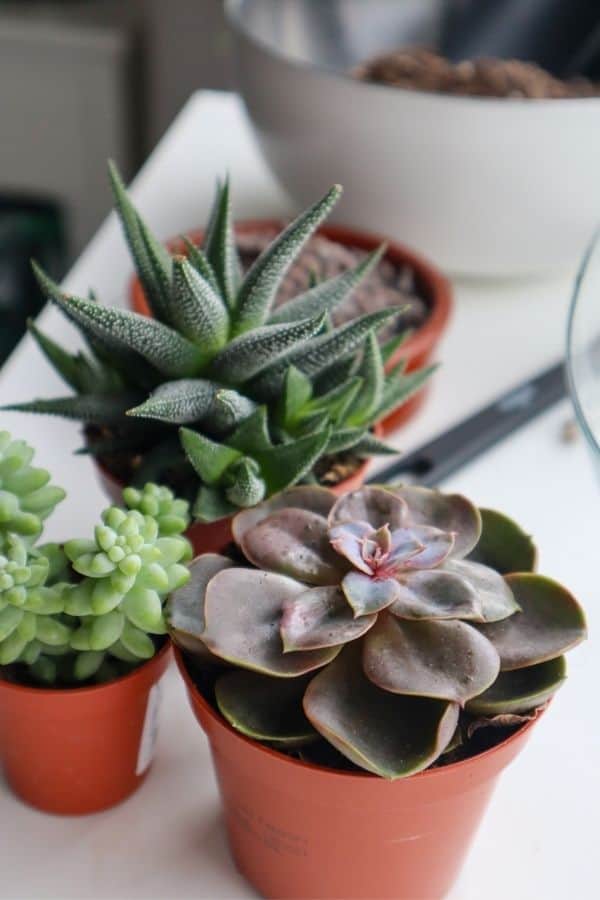
Some of the Best Succulents for Terrariums
There are so many great succulents the choice can be a little overwhelming.
So, to help you find the best succulents for your terrarium project, here are a few examples.
The gorgeous rosettes of the Echeveria and Sempervivum (both commonly referred to as Hens and Chicks) are a great starting point. They contrast nicely with the spiky leaves of the Haworthia (Zebra Plants) and Agave plants.
The String of Pearls (Senecio rowleyanus) is a lovely choice for a cascading succulent vine.
Then, for a bit of verticality – so your arrangement doesn’t look flat – you can look to the Sedum (Burro’s Tail) group, the Crassula Jade Plants, and the Kalanchoe Paddle Plants.
To be honest, I don’t think you can’t go too wrong with grabbing a mix of small assorted succulents. Provided they stay small, they’re all pretty likely to work together!
👉 Shop assorted succulent mixes on Etsy.
How to Care for a Succulent Terrarium
Lighting Requirements
Generally speaking, succulents need lots of light.
Individual requirements will differ slightly depending on the species, but most will thrive with (at least) several hours of direct sunlight and plenty of bright indirect light throughout the day.
It’s worth reading up on your chosen species, to be sure, but you’re unlikely to overdo it on the light.
So, a succulent terrarium will be best placed on a bright windowsill that enjoys direct sunlight, e.g., East and South-facing windows.
How to Water Succulents
Seeing as succulents need so much full sun, they should dry out pretty quickly.
When the substrate is fully dry, it’s time to give it a watering.
You can normally give potted succulents a full soak each time, but with just a drainage layer instead of a drainage hole, you need to be a bit less aggressive with your watering in a terrarium.
Spraying works well, but you don’t want to be regularly wetting the leaves of your succulents, and you need to make sure the water is reaching the roots. Rather than little and often, I prefer to liberally spray (ideally around the base of) the succulents till it’s evenly moist.
Small watering cans are another option that can better direct the water, but you can still overdo it very quickly.
How often you’ll need to water will depend on many factors. From the intensity of your light, the relative humidity, and the amount of water you add. I’d expect to water every 4-7 days, though.
Now It’s Your Turn
We’re at the end of this succulent journey, but yours is just beginning.
I hope you feel fully equipped to tackle your own succulent terrarium DIY project – check out our terrarium supplies range to grab what you need!
Or, if you’re interested in checking out some other kinds of arid plant terrariums, see our Guide to Desert Terrariums.

Really helpful, easy instructions for beginners like me
Thankyou
Can I use a plastic fishbowl? It doesn’t have the larger flared opening like your does, but it is pretty big to allow me to plant in it. I am hoping to set it up soon.
It really depends on the kind of plastic, as the chemicals can potentially leech when in contact with water. If you’re not too attached to your plants, it’s worth giving it a go!
Very helpful information. Thankyou
Thank you for the very helpful information.